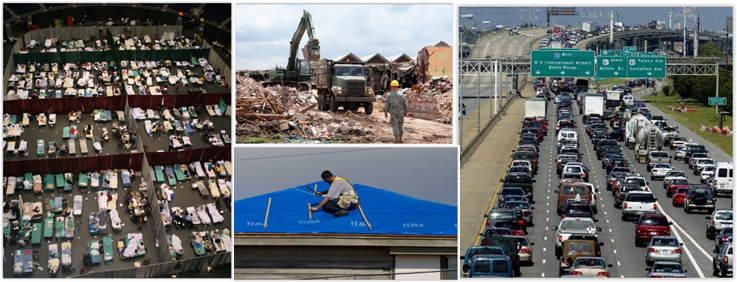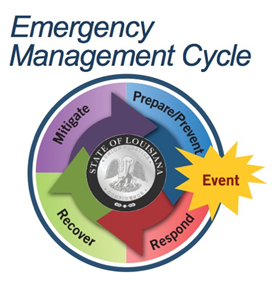Response Overview
Guided by the principles outlined in the National Response Framework (NRF) and enabled by the Louisiana Homeland Security and Emergency Assistance and Disaster Act (Disaster Act), GOHSEP plays a significant role in response to emergencies and disaster events. When the need for resources exceeds the local capacity to provide them, GOHSEP provides assistance to Parishes and local governments. GOHSEP:
Leads, manages and coordinates local and State response actions during an emergency event or disaster.
Coordinates State and Federal Emergency Support Functions (ESFs).
Manages and responds to requests from local, State, Tribal authorities and other entities for needed resources.
Whole community approach
Because government alone cannot meet the challenges posed when responding to a catastrophic incident, GOHSEP response is guided by whole community principles. Whole community is an approach to emergency management that recognizes local, State and Federal government support is only a part of our local, State and Federal emergency management team. The collective team requires the participation of private nonprofit organizations (PNPs), faith-based entities, volunteers, private-sector partners and others.
GOHSEP coordinates response activities with each of these important stakeholders.

State Emergency Operations Center (SEOC)
Importantly GOHSEP activates and coordinates the State Emergency Operations Center (SEOC). The SEOC is a state-of-the-art command and control center, providing support for local governments and other State agencies. ALL requests for assistance and actions during an incident are coordinated through the SEOC.
National Response Framework

The National Response Framework (NRF) is a guide to how the Nation responds to all types of disasters and emergencies. It is built on scalable, flexible, and adaptable concepts identified in the National Incident Management System (NIMS) to align key roles and responsibilities across the Nation to help States and local communities respond to emergency and/or disaster events.
The NRF provides guidance to government executives, private-sector partners, nongovernmental organization (NGO) leaders and emergency managers to facilitate the coordination of roles, responsibilities and relationships that provide needed assistance to local communities impacted by disaster.
The NRF is written for senior elected and appointed leaders, such as Federal department or agency heads, Governors, Parish Presidents, Mayors, Tribal leaders and other Parish or city officials. It provides an organizational structure and guidance to those who are responsible to provide an effective response to preserve the safety and welfare of the community. It specifically establishes a leadership and decision-making structure through the Federal Coordinating Officer (FCO) and his/her counterpart, the State Coordinating Officer (SCO). It also provides a management structure for the coordination, grouping and deployment of response assets – including those that deal with transportation resources, communications, public works, search and rescue and more – through the Emergency Support Functions (ESFs). Both the Federal government and the State have ESFs identified. There are 15 Federal ESFs and 16 State ESFs. See the ESF section of this website for more on the ESF structure.
At the same time, the NRF informs emergency management practitioners and explains the operating structures and systems used routinely by first responders and emergency managers at all levels of government.

Response role in the emergency management cycle
Emergency management functions are generally grouped into four (4) phases:
- Prepare/Prevent
- Respond
- Recover
- Mitigate
Response is the execution of all systems, plans and resources necessary to adequately preserve life, property and the environment during a disaster or emergency.
Emergency management in Louisiana is supported by plans, procedures and partnerships. Logistics pre-disaster planning ensures appropriate systems are in place before a disaster or emergency so that needed resources (equipment, materials, supplies and manpower) are identified and available timely and efficiently to communities when impacted by a disaster or an emergency. While the first source of resources should most logically be those closest to a disaster, there are processes in place to help when disaster-related needs go beyond local capacity.




